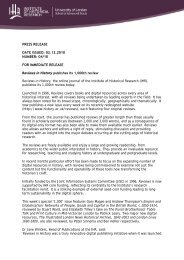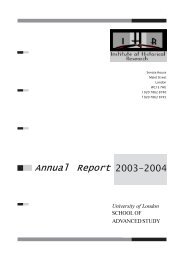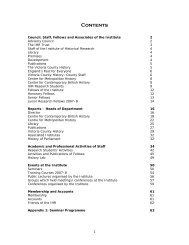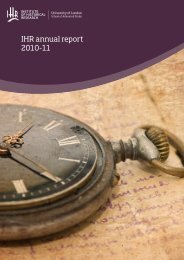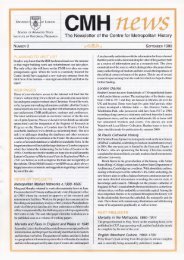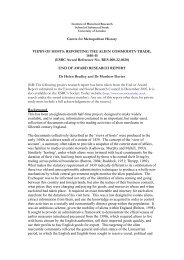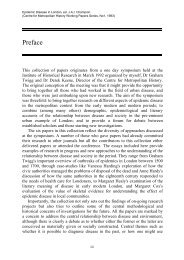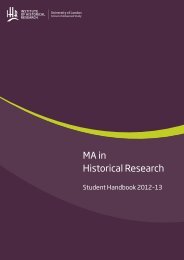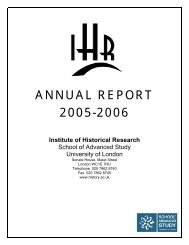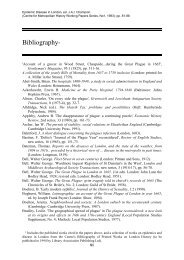Burial of the plague dead in early modern London
Burial of the plague dead in early modern London
Burial of the plague dead in early modern London
You also want an ePaper? Increase the reach of your titles
YUMPU automatically turns print PDFs into web optimized ePapers that Google loves.
Epidemic Disease <strong>in</strong> <strong>London</strong>, ed. J.A.I. Champion<br />
(Centre for Metropolitan History Work<strong>in</strong>g Papers Series, No. 1, 1993):<br />
pp. 53-64 © Vanessa Hard<strong>in</strong>g, 1993<br />
_____________________________________________<br />
<strong>Burial</strong> <strong>of</strong> <strong>the</strong> <strong>plague</strong> <strong>dead</strong> <strong>in</strong> <strong>early</strong> <strong>modern</strong> <strong>London</strong><br />
VANESSA HARDING<br />
_____________________________________________<br />
''Tis certa<strong>in</strong> <strong>the</strong>y died by heaps and were buried by heaps; that is to say, without<br />
account'. 1 Disposal <strong>of</strong> <strong>the</strong> bodies <strong>of</strong> those who died <strong>in</strong> <strong>the</strong> major <strong>plague</strong><br />
epidemics <strong>of</strong> <strong>the</strong> <strong>early</strong> <strong>modern</strong> period undoubtedly presented huge problems for<br />
<strong>the</strong> responsible authorities; but did it descend <strong>in</strong>to chaos, as Defoe suggests it<br />
did <strong>in</strong> 1665? And if it did, how and when did normal patterns <strong>of</strong> burial and<br />
funerary observance break down?<br />
Although <strong>the</strong> gross figures <strong>of</strong> 35,000 <strong>dead</strong> <strong>in</strong> <strong>the</strong> epidemic <strong>of</strong> 1625, or 69,000<br />
<strong>in</strong> 1665, 2 do <strong>in</strong> some sense represent a problem fac<strong>in</strong>g <strong>the</strong> city as a whole, <strong>in</strong><br />
practice <strong>the</strong> problem was confronted at an <strong>in</strong>timate and local level. The way <strong>in</strong><br />
which disposal <strong>of</strong> <strong>the</strong> victims was tackled was shaped by what was regarded as<br />
normal burial practice, by contemporary views on <strong>the</strong> role and competence <strong>of</strong><br />
government, and by <strong>the</strong> epidemiology <strong>of</strong> <strong>the</strong> disease itself. In sixteenth- and<br />
seventeenth-century <strong>London</strong>, <strong>the</strong>se factors comb<strong>in</strong>ed to place <strong>the</strong> major<br />
adm<strong>in</strong>istrative responsibility on <strong>the</strong> parish. In normal times burial <strong>of</strong> <strong>the</strong> <strong>dead</strong> fell<br />
largely with<strong>in</strong> <strong>the</strong> scope <strong>of</strong> parish government - almost all places <strong>of</strong> burial <strong>in</strong><br />
<strong>London</strong> were parish churchyards, all parishioners had <strong>the</strong> right to be buried <strong>the</strong>re<br />
(and most chose to do so), and it was <strong>the</strong> vestry and churchwardens who<br />
controlled burial with<strong>in</strong> <strong>the</strong>ir own parish. They set and collected burial fees,<br />
directed <strong>the</strong> layout <strong>of</strong> graves, and organized <strong>the</strong> acquisition <strong>of</strong> new space for<br />
burial when necessary. Parishes were seen as <strong>the</strong> natural unit <strong>of</strong> local government,<br />
with<strong>in</strong> and without <strong>the</strong> city, and undertook an <strong>in</strong>creas<strong>in</strong>g burden <strong>of</strong> adm<strong>in</strong>istration<br />
<strong>in</strong> this period. The government <strong>of</strong> <strong>the</strong> city <strong>of</strong> <strong>London</strong> had general responsibility<br />
for public hygiene <strong>in</strong> a broad sense <strong>in</strong> <strong>the</strong> city, and <strong>of</strong> course issued <strong>the</strong> <strong>plague</strong><br />
orders, which make some reference to burial, but even <strong>the</strong>se delegated<br />
1 Daniel Defoe, A Journal <strong>of</strong> <strong>the</strong> Plague Year (Pengu<strong>in</strong> Classics edition, 1986), p. 246.<br />
2 Attributed <strong>plague</strong> deaths <strong>of</strong> 35,417 (1625) and 68,596 (1665) from A collection <strong>of</strong> <strong>the</strong> y<strong>early</strong> bills<br />
<strong>of</strong> mortality from 1657 to 1758 <strong>in</strong>clusive (1759); hereafter cited as Y<strong>early</strong> Bills.<br />
53
54 Epidemic Disease <strong>in</strong> <strong>London</strong><br />
___________________________________________________________________________<br />
most tasks to <strong>the</strong> parishes. 3 Only, it seems, when <strong>the</strong> parishes' ability to cope<br />
was break<strong>in</strong>g down did <strong>the</strong> city government itself take action.<br />
The burden <strong>of</strong> dispos<strong>in</strong>g <strong>of</strong> <strong>the</strong> <strong>dead</strong>, and <strong>the</strong> resources to do it with, were<br />
very unevenly spread across <strong>the</strong> capital. The 120-130 parishes covered <strong>in</strong> <strong>the</strong><br />
Bills <strong>of</strong> Mortality varied hugely <strong>in</strong> size, population and social character, and <strong>in</strong><br />
<strong>the</strong> space <strong>the</strong>y had for burial. Moreover, as we know, <strong>the</strong> <strong>plague</strong> epidemics <strong>of</strong><br />
<strong>early</strong> <strong>modern</strong> <strong>London</strong> did not hit all areas <strong>of</strong> <strong>the</strong> capital with equal force. By <strong>the</strong><br />
seventeenth century <strong>the</strong> <strong>in</strong>ner city was less severely affected by <strong>plague</strong> mortality<br />
than extramural and suburban areas, and it also had greater resources to deal<br />
with <strong>the</strong> problem: <strong>the</strong> average size <strong>of</strong> <strong>the</strong> parish was much smaller, <strong>the</strong> wealth <strong>of</strong><br />
<strong>in</strong>habitants greater, while mortality rates were higher and absolute numbers <strong>of</strong><br />
<strong>dead</strong> each parish dealt with very much greater fur<strong>the</strong>r from <strong>the</strong> centre. 4 Local<br />
responses also reflected vary<strong>in</strong>g local conditions and traditions <strong>of</strong> burial, <strong>of</strong>ten<br />
established over a long period. 5<br />
The epidemiology <strong>of</strong> <strong>the</strong> disease contributed to <strong>the</strong> problem: its rapid spread<br />
over short distances, its high case-fatality, <strong>the</strong> geometrical <strong>in</strong>crease <strong>in</strong> weekly<br />
deaths once it had taken hold <strong>in</strong> an area, helped to concentrate most <strong>of</strong> <strong>the</strong><br />
deaths <strong>in</strong> a parish <strong>in</strong> a relatively short period <strong>of</strong> time. The practice <strong>of</strong> shutt<strong>in</strong>g up<br />
whole households after one confirmed case may have <strong>in</strong>creased local mortality,<br />
and also meant that <strong>the</strong> family could not take its usual share <strong>of</strong> responsibility for<br />
organiz<strong>in</strong>g and pay<strong>in</strong>g for burial - even had participation <strong>in</strong> funerals and<br />
processions not been restricted by <strong>the</strong> Plague Orders. An important factor<br />
shap<strong>in</strong>g <strong>the</strong> parishes' response to <strong>the</strong> problems <strong>of</strong> epidemic burial was <strong>the</strong> strong<br />
popular attachment to traditional practices: <strong>the</strong> <strong>in</strong>dividual funeral and <strong>in</strong>terment,<br />
<strong>in</strong> which <strong>the</strong> family played an important role; <strong>the</strong> attendance <strong>of</strong> friends and<br />
neighbours; <strong>the</strong> desire for commemoration. 6 These desires were <strong>in</strong> conflict with<br />
<strong>the</strong> Plague Orders and orders <strong>of</strong> <strong>the</strong> Privy Council, which aimed to<br />
3 Plague orders for 1665 quoted <strong>in</strong> Defoe, Plague Year, pp. 57-66; cf. Paul Slack, 'Metropolitan<br />
government <strong>in</strong> crisis' <strong>in</strong> A.L. Beier and Roger F<strong>in</strong>lay (eds.), <strong>London</strong> 1500-1700. The mak<strong>in</strong>g <strong>of</strong> <strong>the</strong><br />
metropolis (1986), p. 68.<br />
4 Slack, 'Metropolitan government', pp. 62-4, 70. The parish <strong>of</strong> St Bride <strong>in</strong> <strong>the</strong> western suburbs <strong>of</strong><br />
<strong>the</strong> city (about 29 acres) buried 2111 persons <strong>in</strong> 1665 (5½ times its normal y<strong>early</strong> mean <strong>of</strong> 375), while<br />
<strong>in</strong> an area <strong>of</strong> equivalent size <strong>in</strong> <strong>the</strong> city centre, 13 parishes (All Hallows Bread Street, All Hallows<br />
Honey Lane, St Anton<strong>in</strong>, St Benet Sherehog, St Lawrence Jewry, St Mart<strong>in</strong> Pomary, St Mary<br />
Aldermary, St Mary le Bow, St Mary Colechurch, St Mary Magdalen Milk Street, St Mildred Poultry,<br />
St Olave Old Jewry, St Pancras Soper Lane: total area, 28.56 acres) were responsible for dispos<strong>in</strong>g <strong>of</strong><br />
only 611 corpses, 2½ times <strong>the</strong> annual mean <strong>of</strong> 238: Y<strong>early</strong> Bills.<br />
5 Most <strong>London</strong> parishes had at least one churchyard, but a few had none, and several had two or<br />
more. Some <strong>of</strong> those acquir<strong>in</strong>g new burial space <strong>in</strong> <strong>the</strong> <strong>early</strong> <strong>modern</strong> period made status dist<strong>in</strong>ctions<br />
between old and new churchyards: Vanessa Hard<strong>in</strong>g, ' "And one more may be laid <strong>the</strong>re": <strong>the</strong> location<br />
<strong>of</strong> burials <strong>in</strong> <strong>early</strong> <strong>modern</strong> <strong>London</strong>', <strong>London</strong> Journal, 14 (1989), pp. 115-118.<br />
6 'Plague epidemics provide a touchstone aga<strong>in</strong>st which to measure <strong>the</strong> strength <strong>of</strong> commitment to<br />
<strong>the</strong> traditional and customary burial rites <strong>in</strong> <strong>early</strong> <strong>modern</strong> England': Clare Gitt<strong>in</strong>gs, Death, burial and<br />
<strong>the</strong> <strong>in</strong>dividual <strong>in</strong> <strong>early</strong> <strong>modern</strong> England (1984), p. 80.
<strong>Burial</strong> <strong>of</strong> <strong>the</strong> <strong>plague</strong> <strong>dead</strong> 55<br />
___________________________________________________________________________<br />
restrict public assemblies and processions. Parish <strong>of</strong>ficers coped as best <strong>the</strong>y<br />
could with <strong>the</strong>se conflict<strong>in</strong>g pressures, and with <strong>the</strong> enormous f<strong>in</strong>ancial burden<br />
<strong>the</strong> epidemic placed on <strong>the</strong>ir straitened resources.<br />
The pr<strong>in</strong>cipal sources for this study are parish records: burial registers, vestry<br />
m<strong>in</strong>utes, and churchwardens' accounts. These are plentiful and <strong>of</strong>ten very explicit,<br />
and survival has been good, but <strong>the</strong> data for an overview <strong>of</strong> <strong>plague</strong> burial is<br />
scattered among hundreds <strong>of</strong> manuscripts. 7 A major problem with parish records<br />
as a source for <strong>the</strong> study <strong>of</strong> epidemic burial, however, is that normal practices <strong>of</strong><br />
record-keep<strong>in</strong>g were liable, under <strong>the</strong> extreme pressure <strong>of</strong> <strong>the</strong> epidemic itself, to<br />
break down. Parish clerks and <strong>of</strong>ficers might die, or quit <strong>the</strong>ir posts, or <strong>the</strong> volume<br />
<strong>of</strong> events for record<strong>in</strong>g might simply overwhelm <strong>the</strong>m or <strong>the</strong>ir successors. Parish<br />
registers, accounts, and m<strong>in</strong>utes were not always written up event by event, even <strong>in</strong><br />
normal times, but were made up from contemporary notes, which may not have<br />
survived <strong>the</strong> confusion. 8 Even when records were kept, <strong>the</strong>y may have become<br />
attenuated and patchy, with many silent omissions. Many parishes have defective<br />
registers for 1665-6: <strong>the</strong> Great Fire <strong>of</strong> September 1666 probably destroyed a<br />
quantity <strong>of</strong> papers, less carefully conserved than <strong>the</strong> registers and parish books<br />
<strong>the</strong>mselves, which would o<strong>the</strong>rwise have been used to complete <strong>the</strong> record.<br />
The records <strong>of</strong> St Bride Fleet Street, <strong>in</strong> <strong>the</strong> western suburbs <strong>of</strong> <strong>the</strong> city <strong>of</strong><br />
<strong>London</strong>, <strong>of</strong>fer an example <strong>of</strong> how one parish coped dur<strong>in</strong>g <strong>the</strong> <strong>plague</strong> <strong>of</strong> 1665. 9<br />
Total deaths <strong>in</strong> <strong>the</strong> parish <strong>in</strong> <strong>the</strong> year 1665 came to 2,111 (five and a half times<br />
normal), <strong>of</strong> which 1,427 were attributed to <strong>plague</strong>. 10 The disease established itself<br />
<strong>in</strong> <strong>the</strong> nor<strong>the</strong>rn and western suburbs <strong>of</strong> <strong>London</strong> <strong>in</strong> <strong>the</strong> month <strong>of</strong> May. St Bride's<br />
burial register does not dist<strong>in</strong>guish <strong>plague</strong> deaths, but no elevation <strong>of</strong> deaths<br />
above normal levels is visible until mid-June. Thirty-two people were buried <strong>in</strong><br />
May, 22 <strong>in</strong> <strong>the</strong> first half <strong>of</strong> June, 34 <strong>in</strong> <strong>the</strong> second half. 11 The first reference to<br />
<strong>plague</strong> <strong>in</strong> <strong>the</strong> vestry m<strong>in</strong>utes is a meet<strong>in</strong>g called on 16 June, before <strong>the</strong> publication<br />
<strong>of</strong> <strong>the</strong> Plague Orders, 'to consider <strong>of</strong> several th<strong>in</strong>gs necessary <strong>in</strong> this time <strong>of</strong><br />
visitation'.<br />
7 See Joan Bullock-Anderson, Clare Clubb and Jacquel<strong>in</strong>e Cox (compilers), A guide to archives and<br />
manuscripts at Guildhall Library (1989).<br />
8 The churchwardens <strong>of</strong> St Dunstan <strong>in</strong> <strong>the</strong> West were unable to <strong>in</strong>clude <strong>the</strong> usual itemized list <strong>of</strong><br />
burials and burial fees for <strong>the</strong> period July-December 1666 <strong>in</strong> <strong>the</strong>ir f<strong>in</strong>al fair account, '<strong>the</strong> particulars ...<br />
be<strong>in</strong>g lost [by <strong>the</strong> parish clerk] <strong>in</strong> <strong>the</strong> tyme <strong>of</strong> sickness'. The parish clerk died <strong>in</strong> November 1666,<br />
before <strong>the</strong> account for 1665 had been audited. GL MS 2968/4, ff. 432v-436v.<br />
9 Unless o<strong>the</strong>rwise stated, <strong>the</strong> sources for this section are GL MS 6540/1, Register <strong>of</strong> baptisms,<br />
marriages and burials, 1653-72; GL MS 6552/1, Churchwardens' Accounts 1639-78; GL MS 6554/1,<br />
Vestry M<strong>in</strong>utes 1644-65.<br />
10 These figures, and <strong>the</strong> average <strong>of</strong> 373 deaths per annum 1660-4, are from Y<strong>early</strong> Bills.<br />
11 Thirty-five and 30 had been buried <strong>in</strong> May and June 1663, 39 and 31 <strong>in</strong> May and June 1664: GL<br />
MS 6540/1.
56 Epidemic Disease <strong>in</strong> <strong>London</strong><br />
___________________________________________________________________________<br />
At this meet<strong>in</strong>g <strong>the</strong>y organized searchers <strong>of</strong> <strong>the</strong> <strong>dead</strong>, appo<strong>in</strong>ted bearers for <strong>the</strong><br />
<strong>plague</strong> <strong>dead</strong>, fixed <strong>the</strong>ir wages, and established accommodation for <strong>the</strong>m <strong>in</strong> <strong>the</strong><br />
churchyard where <strong>the</strong>y would not mix with o<strong>the</strong>r people. The churchwardens<br />
were to direct <strong>the</strong> gravedigger where to make graves; and <strong>the</strong>y decided, 'because<br />
our ground beg<strong>in</strong>s to fill', not to accept any more bodies from <strong>the</strong> neighbour<strong>in</strong>g<br />
parish <strong>of</strong> St Mart<strong>in</strong> Ludgate except on payment <strong>of</strong> double duties. On 3 July <strong>the</strong>y<br />
decided to give extra remuneration to <strong>the</strong> gravedigger to encourage him to dig<br />
graves deep 'as it is ordered [<strong>in</strong> <strong>the</strong> Plague Orders] and as <strong>the</strong> time requires'.<br />
On 7 July <strong>the</strong>y agreed to appo<strong>in</strong>t and pay bearers <strong>of</strong> <strong>plague</strong> <strong>dead</strong> jo<strong>in</strong>tly with<br />
<strong>the</strong> neighbour<strong>in</strong>g parish, St Dunstan <strong>in</strong> <strong>the</strong> West, and four days later appo<strong>in</strong>ted<br />
two more bearers to replace one who had died. Payments to <strong>the</strong>se bearers recur<br />
several times <strong>in</strong> <strong>the</strong> accounts, and <strong>in</strong> <strong>the</strong> accounts for St Dunstan's parish. 12 On<br />
11 July <strong>the</strong> vestry <strong>of</strong> St Bride also decided to bury no more <strong>plague</strong> victims<br />
with<strong>in</strong> <strong>the</strong> church, but to allow parish notables and <strong>the</strong> better-<strong>of</strong>f who died <strong>of</strong> <strong>the</strong><br />
<strong>plague</strong> ('and none o<strong>the</strong>r') to be buried <strong>in</strong> <strong>the</strong> upper churchyard. In <strong>the</strong> <strong>early</strong><br />
weeks <strong>of</strong> <strong>the</strong> <strong>plague</strong> <strong>the</strong> parish paid for <strong>the</strong> burial <strong>of</strong> several <strong>in</strong>dividuals,<br />
<strong>in</strong>clud<strong>in</strong>g parish pensioners and children, but <strong>the</strong>re is no reference to <strong>the</strong>ir<br />
buy<strong>in</strong>g a c<strong>of</strong>f<strong>in</strong> for anyone between 26 July and 8 October; <strong>the</strong> implication is<br />
that between <strong>the</strong>se dates all burials paid for by <strong>the</strong> parish were <strong>in</strong> sheets or<br />
shrouds only. Mortality began to soar upwards from mid-July: 110 were buried<br />
<strong>in</strong> <strong>the</strong> last two weeks <strong>in</strong> July, and 189 <strong>in</strong> <strong>the</strong> first fortnight <strong>in</strong> August. By 12<br />
August <strong>the</strong> vestry was concerned at <strong>the</strong> rapidity with which burial space was<br />
fill<strong>in</strong>g up. Although <strong>the</strong>y thought it necessary to appo<strong>in</strong>t someone 'to see <strong>the</strong><br />
ground be well husbanded', and to take charge <strong>of</strong> pay<strong>in</strong>g <strong>the</strong> gravemaker and <strong>the</strong><br />
labourers employed to dig graves, no one could be found will<strong>in</strong>g to undertake<br />
this. Perhaps as a result <strong>of</strong> this failure, as well as <strong>of</strong> <strong>in</strong>creas<strong>in</strong>g mortality<br />
(heaviest between mid-August and mid-September, when recorded burials<br />
totalled 831, <strong>of</strong>ten over 30 per day), traditional burial practice began to break<br />
down. What Defoe calls 'burial <strong>in</strong> form' 13 - <strong>the</strong> <strong>in</strong>dividual service and <strong>in</strong>terment -<br />
was <strong>in</strong> part at least replaced by mass burial <strong>in</strong> a common grave. The parish's first<br />
substantial common grave or pit was dug <strong>in</strong> late August. 14 We do not know how<br />
this was used, but <strong>the</strong> probability is that it was filled up over a matter <strong>of</strong> days or<br />
weeks and <strong>the</strong>n closed, and a new one opened. Payments <strong>in</strong> <strong>the</strong> churchwardens'<br />
accounts suggest that a second pit was dug <strong>in</strong> <strong>early</strong> September and perhaps a<br />
third <strong>in</strong> late September, with more work 'digg<strong>in</strong>g <strong>in</strong> <strong>the</strong> pit' <strong>in</strong> mid-October.<br />
At <strong>the</strong> end <strong>of</strong> August <strong>the</strong> vestry felt sufficiently <strong>in</strong> control <strong>of</strong> th<strong>in</strong>gs to defer a<br />
petition for a gravemaker's place until suitable competition could be found, and<br />
12 For St Dunstan's, see GL MS 2968/4, Churchwardens' Accounts 1645-65.<br />
13 Defoe, Plague Year, p. 106.<br />
14 Two labourers worked on <strong>the</strong> pit for six days and five for four days, and were paid on 26 August:<br />
GL MS 6552/1.
<strong>Burial</strong> <strong>of</strong> <strong>the</strong> <strong>plague</strong> <strong>dead</strong> 57<br />
___________________________________________________________________________<br />
rejected a petition for a bearer's place s<strong>in</strong>ce <strong>the</strong> present bearers were able to<br />
cope. 15 In fact mortality did not beg<strong>in</strong> to decl<strong>in</strong>e until late September: deaths did<br />
not exceed 20 per day after 18 September, and were <strong>in</strong> s<strong>in</strong>gle figures from 11<br />
October, but <strong>the</strong> first day with no burial at all was 11 November and not until<br />
December was <strong>the</strong> monthly total (29) down to previous levels. More work was<br />
done on or <strong>in</strong> '<strong>the</strong> pit' <strong>in</strong> December 1665 and February 1666, but probably by <strong>the</strong><br />
latter date this was consolidat<strong>in</strong>g and levell<strong>in</strong>g.<br />
St Bride's, though a large and populous parish, never<strong>the</strong>less had a reasonable<br />
amount <strong>of</strong> churchyard space, hav<strong>in</strong>g acquired a new site for burial <strong>of</strong> about a<br />
quarter <strong>of</strong> an acre (large by <strong>London</strong> standards) <strong>in</strong> 1610. 16 This new site was a few<br />
hundred yards from <strong>the</strong> church, near Fleet Ditch, and was known as <strong>the</strong> 'lower<br />
churchyard'; <strong>the</strong> 'upper churchyard', also superior <strong>in</strong> status, was <strong>the</strong> older graveyard<br />
by <strong>the</strong> church. The burial register gives no clue to <strong>the</strong> location <strong>of</strong> burials, ei<strong>the</strong>r<br />
before or dur<strong>in</strong>g <strong>the</strong> <strong>plague</strong>, but <strong>the</strong> vestry order cited above, bann<strong>in</strong>g church burial<br />
<strong>of</strong> <strong>plague</strong> victims and restrict<strong>in</strong>g <strong>the</strong> upper churchyard to a few, should have meant<br />
that n<strong>early</strong> all <strong>plague</strong> victims buried with<strong>in</strong> <strong>the</strong> parish went to <strong>the</strong> lower<br />
churchyard, and this is almost certa<strong>in</strong>ly where <strong>the</strong> pits were dug.<br />
The records <strong>of</strong> St Bride's seem to show <strong>the</strong> parish as an adm<strong>in</strong>istrative unit and<br />
as a community struggl<strong>in</strong>g under <strong>the</strong> pressure <strong>of</strong> events but not overwhelmed. The<br />
accounts are <strong>in</strong> remarkably good order, despite <strong>the</strong> deaths <strong>of</strong> <strong>the</strong> senior<br />
churchwarden and his successor <strong>in</strong> late September and <strong>early</strong> October. The clerk or<br />
sexton cont<strong>in</strong>ued to send <strong>in</strong> monthly accounts <strong>of</strong> burial fees, <strong>in</strong>dicat<strong>in</strong>g that<br />
<strong>in</strong>dividual <strong>in</strong>terments cont<strong>in</strong>ued alongside <strong>the</strong> mass burials throughout <strong>the</strong> period<br />
<strong>of</strong> <strong>the</strong> <strong>plague</strong> (even, by October, <strong>in</strong> <strong>the</strong> church), though not all those listed were<br />
necessarily <strong>plague</strong> victims. 17 The only major loss is <strong>of</strong> <strong>the</strong> vestry m<strong>in</strong>utes from 28<br />
August onwards, and this may be due to <strong>the</strong> Fire, not <strong>the</strong> <strong>plague</strong>. 18<br />
The records <strong>of</strong> St Bride's also show that at least two <strong>of</strong> <strong>the</strong> expedients <strong>of</strong>ten<br />
considered characteristic <strong>of</strong> <strong>plague</strong> burial <strong>in</strong> <strong>London</strong>, <strong>the</strong> organized collection <strong>of</strong><br />
corpses and <strong>the</strong> open<strong>in</strong>g <strong>of</strong> mass graves, were at least to beg<strong>in</strong> with parish<br />
<strong>in</strong>itiatives. St Bride's and St Dunstan's jo<strong>in</strong>tly employed a party <strong>of</strong> bearers from<br />
15 GL MS 6554/1, f. 290.<br />
16 GL MS 9531/13, pt. 2, ff. 394v-395v<br />
17 GL MS 6570/1, items 62-9. These accounts only list a small fraction <strong>of</strong> <strong>the</strong> burials recorded <strong>in</strong> <strong>the</strong><br />
register (89 out <strong>of</strong> 610 <strong>in</strong> August, 107 out <strong>of</strong> 635 <strong>in</strong> September, 58 out <strong>of</strong> 246 <strong>in</strong> October). In June<br />
1665 <strong>the</strong> vestry had <strong>in</strong>structed <strong>the</strong> clerk to take <strong>the</strong> usual fee paid for bearers from '<strong>the</strong> persons visited<br />
that are able to pay' and account for it to <strong>the</strong> churchwardens with pits and knells: GL MS 6554/1, f.<br />
275v.<br />
18 GL MS 6554/1 is written right up to <strong>the</strong> flyleaf, and <strong>the</strong> last meet<strong>in</strong>g recorded is 28 August.<br />
Presumably some record <strong>of</strong> cont<strong>in</strong>u<strong>in</strong>g meet<strong>in</strong>gs was kept, but <strong>the</strong> next surviv<strong>in</strong>g volume <strong>of</strong> m<strong>in</strong>utes<br />
beg<strong>in</strong>s <strong>in</strong> 1681.
58 Epidemic Disease <strong>in</strong> <strong>London</strong><br />
___________________________________________________________________________<br />
July onwards; an <strong>early</strong> reference to 'sl<strong>in</strong>ges to carry <strong>the</strong> <strong>dead</strong> corpes', 19 and <strong>the</strong><br />
absence <strong>of</strong> any later references to carts suggests that bear<strong>in</strong>g was always done on<br />
foot <strong>in</strong> <strong>the</strong>se parishes. O<strong>the</strong>r parishes, perhaps especially <strong>the</strong> larger ones, bought or<br />
hired carts as <strong>the</strong>y found necessary. 20 It is difficult to discover whe<strong>the</strong>r a<br />
centralized system <strong>of</strong> <strong>dead</strong>-carts ever existed, or whe<strong>the</strong>r it was always carried out<br />
by parishes, perhaps act<strong>in</strong>g toge<strong>the</strong>r <strong>in</strong> groups. Defoe says that '<strong>the</strong> <strong>dead</strong> carts <strong>in</strong><br />
<strong>the</strong> city were not conf<strong>in</strong>ed to particular parishes, but one cart went through several<br />
parishes, accord<strong>in</strong>g as <strong>the</strong> number <strong>of</strong> <strong>dead</strong> presented,' 21 but, if this is so, <strong>the</strong> means<br />
by which this was organized and f<strong>in</strong>anced is not clear.<br />
Whoever organized <strong>the</strong> bear<strong>in</strong>g, <strong>the</strong> restriction to night-time collection and<br />
burial was imposed by <strong>the</strong> Privy Council. The City had at first resisted <strong>the</strong> idea<br />
<strong>of</strong> night burial, believ<strong>in</strong>g this might facilitate <strong>the</strong> concealment <strong>of</strong> <strong>plague</strong> deaths,<br />
but by <strong>the</strong> seventeenth century this requirement was <strong>the</strong> norm. 22 It was not<br />
always observed, however; Pepys commented on 12 August that <strong>the</strong> nights were<br />
too short to bury all <strong>the</strong> <strong>dead</strong>, and though he was particularly conscious <strong>of</strong> <strong>the</strong><br />
danger <strong>of</strong> meet<strong>in</strong>g corpses be<strong>in</strong>g carried out at night, he also saw public,<br />
presumably daytime, funerals. On 6 September he noted 'strange to see <strong>in</strong> broad<br />
daylight two or three <strong>Burial</strong>ls upon Bankside' and <strong>in</strong> mid-September<br />
encountered corpses be<strong>in</strong>g carried though <strong>the</strong> city at noonday. 23<br />
Mass graves were probably never dug <strong>in</strong> <strong>London</strong> outside epidemics: <strong>the</strong><br />
<strong>in</strong>dividual burial was standard, though two or three might share a grave, and<br />
new graves might well disturb earlier burials. 24 There is literary evidence for<br />
communal graves <strong>in</strong> <strong>the</strong> 1603 and 1625 epidemics, but an extensive search<br />
would be necessary to discover <strong>the</strong> earliest reference among parish records. 25<br />
Many, probably most, <strong>of</strong> <strong>the</strong>se large pits were <strong>in</strong> exist<strong>in</strong>g churchyards, created<br />
by <strong>the</strong> parish when its need for burial space became critical. In <strong>the</strong> 1665 <strong>plague</strong>,<br />
19 St Bride's accounts (GL MS 6552/1), 14 June 1665.<br />
20 The <strong>dead</strong> carts did not 'beg<strong>in</strong> to go about' Defoe's parish, St Botolph Aldgate, until <strong>the</strong> beg<strong>in</strong>n<strong>in</strong>g<br />
<strong>of</strong> August 1665: Plague Year, p. 78. The parish <strong>of</strong> St Margaret Westm<strong>in</strong>ster began with a board to<br />
carry <strong>the</strong> <strong>dead</strong> on, <strong>the</strong>n hired a cart, and later bought one: Walter George Bell, The Great Plague <strong>in</strong><br />
<strong>London</strong> <strong>in</strong> 1665 (1924), p. 51.<br />
21 Defoe, Plague Year, p.108.<br />
22 Charles F. Mullett, The bubonic <strong>plague</strong> <strong>in</strong> England. An essay <strong>in</strong> <strong>the</strong> history <strong>of</strong> preventive medic<strong>in</strong>e.<br />
(1956), pp. 69, 111, 149.<br />
23 The Diary <strong>of</strong> Samuel Pepys, ed. Robert Latham and William Mat<strong>the</strong>ws, Vol. VI, 1665 (1972), 12<br />
August, 15 August, 20 August, 3 Sept., 6 Sept., 14 Sept.<br />
24 Hard<strong>in</strong>g, 'And one more', pp. 116-117.<br />
25 'Open graves where sundry are buried toge<strong>the</strong>r': J. Balmford, A short dialogue concern<strong>in</strong>g <strong>the</strong><br />
<strong>plague</strong>s <strong>in</strong>fection (<strong>London</strong>, 1603), p. 32, quoted by Slack, 'Metropolitan government', p. 75; 'an<br />
hundred hungry graves' each to be daily filled with 60 bodies: Thomas Dekker, The wonderfull year<br />
(1603), <strong>in</strong> F.P. Wilson (ed.), The <strong>plague</strong> pamphlets <strong>of</strong> Thomas Dekker (1925), pp. 28-9; '<strong>the</strong>y are<br />
compelled to dig Graves like little cellers, pil<strong>in</strong>g up forty or fifty <strong>in</strong> a Pit': Dekker, A rod for runawaies<br />
(1625), <strong>in</strong> Wilson, op. cit., pp. 158-9.
<strong>Burial</strong> <strong>of</strong> <strong>the</strong> <strong>plague</strong> <strong>dead</strong> 59<br />
___________________________________________________________________________<br />
at St Dunstan <strong>in</strong> <strong>the</strong> West, <strong>the</strong> first pits were dug <strong>in</strong> mid-August; at St Bride's, as<br />
we have seen, <strong>in</strong> late August. 26 At St Botolph Aldgate a number <strong>of</strong> pits were dug<br />
<strong>in</strong> August, but <strong>the</strong> 'great pit' <strong>in</strong> <strong>the</strong> churchyard, and which came to conta<strong>in</strong> over a<br />
thousand bodies, received its first corpse on 6 September, accord<strong>in</strong>g to Defoe's<br />
account. 'Some blamed <strong>the</strong> churchwardens for suffer<strong>in</strong>g such a frightful th<strong>in</strong>g ...<br />
but time made it appear <strong>the</strong> churchwardens knew <strong>the</strong> condition <strong>of</strong> <strong>the</strong> parish<br />
better than <strong>the</strong>y did': with<strong>in</strong> a fortnight it had been filled up with 1,114 bodies. 27<br />
It seems likely that most, perhaps all, <strong>of</strong> <strong>the</strong> larger suburban parishes <strong>of</strong> <strong>London</strong><br />
ended by bury<strong>in</strong>g <strong>the</strong>ir <strong>plague</strong> <strong>dead</strong> <strong>in</strong> mass graves, but that <strong>the</strong> smaller citycentre<br />
parishes did not need to do so. The ma<strong>in</strong> motive for digg<strong>in</strong>g mass graves<br />
was obviously to accommodate <strong>the</strong> maximum number <strong>of</strong> corpses <strong>in</strong> a small<br />
space, but <strong>the</strong> parishes may also have been driven to it to save money. They<br />
were shoulder<strong>in</strong>g <strong>the</strong> massive f<strong>in</strong>ancial burden <strong>of</strong> support<strong>in</strong>g 'visited' families,<br />
watch<strong>in</strong>g houses, search<strong>in</strong>g and report<strong>in</strong>g <strong>the</strong> <strong>dead</strong>, and by <strong>the</strong> height <strong>of</strong> <strong>the</strong><br />
epidemic <strong>the</strong> great majority <strong>of</strong> families could make no contribution to <strong>the</strong> cost<br />
<strong>of</strong> burial. 28 Though <strong>the</strong> pits were expensive to dig, tak<strong>in</strong>g several days' labour,<br />
<strong>the</strong>y were cheap to fill, while <strong>in</strong>dividual graves and <strong>in</strong>terments would have been<br />
more costly, even had space been available.<br />
One <strong>of</strong> <strong>the</strong> most popular elements <strong>in</strong> <strong>the</strong> mythology <strong>of</strong> <strong>London</strong> is <strong>the</strong> <strong>plague</strong><br />
pit, and especially <strong>the</strong> idea that many pits were dug <strong>in</strong> unconsecrated ground<br />
and afterwards forgotten. The site <strong>of</strong> any discovery <strong>of</strong> plentiful human rema<strong>in</strong>s<br />
<strong>in</strong> a location no longer used for burial tends to be identified as a <strong>plague</strong> pit,<br />
unless a more reliable history is quickly attached to it. There were undoubtedly<br />
some temporary and irregular <strong>plague</strong> burial sites, but though few are well<br />
documented, <strong>the</strong>ir overall number may have been quite limited. Defoe is our<br />
ma<strong>in</strong> source for new or temporary burial grounds opened <strong>in</strong> 1665. He suggests<br />
that 'many if not all <strong>of</strong> <strong>the</strong> out-parishes were obliged to make new bury<strong>in</strong>ggrounds',<br />
though he concentrates on <strong>the</strong> nor<strong>the</strong>rn and eastern suburbs <strong>of</strong> <strong>the</strong> city<br />
ra<strong>the</strong>r than Westm<strong>in</strong>ster or Southwark. He mentions '<strong>the</strong> great pit <strong>in</strong> F<strong>in</strong>sbury<br />
Fields', and lists sites or grounds (not necessarily pits) near Goswell Street, <strong>in</strong><br />
Shoreditch, at Moorfields, and <strong>of</strong>f Bishopsgate Street, and eight <strong>in</strong> <strong>the</strong> huge<br />
parish <strong>of</strong> Stepney. His account cl<strong>early</strong> associates several <strong>of</strong> <strong>the</strong>se with use by a<br />
particular parish or hamlet, though some may have been shared, and <strong>the</strong> <strong>dead</strong><br />
carts may have used <strong>the</strong>m more <strong>in</strong>discrim<strong>in</strong>ately. 29 These new grounds seem to<br />
fit with<strong>in</strong> <strong>the</strong> general pattern <strong>of</strong> parish responsibility for burial outl<strong>in</strong>ed above;<br />
26 GL MS 2968/4, 16 August 1665.<br />
27 Defoe, Plague Year, pp. 77-8.<br />
28 At St Bride's, fees were paid for 89 burials <strong>in</strong> August, 107 <strong>in</strong> September, and 58 <strong>in</strong> October: GL<br />
MS 5570/1, items 62-9. The register records 610, 635, and 246 burials <strong>in</strong> <strong>the</strong> same months: GL MS<br />
6540/1. The clerk had been <strong>in</strong>structed to take <strong>the</strong> usual fees from '<strong>the</strong> persons visited that are able to<br />
pay': GL MS 6554/1, f. 275v.<br />
29 Defoe, Plague Year, pp. 192, 240-2.
60 Epidemic Disease <strong>in</strong> <strong>London</strong><br />
___________________________________________________________________________<br />
<strong>the</strong> scarcity <strong>of</strong> evidence for <strong>the</strong>m <strong>in</strong> parish records may suggest that <strong>the</strong>se were<br />
late and desperate expedients, <strong>in</strong>voked when record-keep<strong>in</strong>g had already broken<br />
down. W.G. Bell, <strong>in</strong> general a ra<strong>the</strong>r uncritical reporter <strong>of</strong> <strong>plague</strong> pits, 30 suggests<br />
ano<strong>the</strong>r group <strong>of</strong> new burial sites, those attached to pest-houses. The pest-house<br />
<strong>in</strong> <strong>the</strong> parish <strong>of</strong> St Mart<strong>in</strong> <strong>in</strong> <strong>the</strong> Fields (which also served a number <strong>of</strong> o<strong>the</strong>r<br />
parishes) had a fenced burial ground, used by a number <strong>of</strong> parishes at <strong>the</strong> height<br />
<strong>of</strong> <strong>the</strong> epidemic; <strong>dead</strong> from <strong>the</strong> pest-house at Westm<strong>in</strong>ster were probably buried<br />
<strong>in</strong> a marked-<strong>of</strong>f part <strong>of</strong> Tothill Fields, along with <strong>plague</strong> <strong>dead</strong> from <strong>the</strong> parish <strong>of</strong><br />
St Margaret's as a whole. 31 The City pest-house returned separate numbers <strong>of</strong><br />
<strong>dead</strong> from <strong>the</strong> parochial totals <strong>in</strong> <strong>the</strong> Bills <strong>of</strong> Mortality, but it is not clear where<br />
<strong>the</strong>y were buried; possibly <strong>the</strong> nearby 'great pit <strong>in</strong> F<strong>in</strong>sbury Fields'<br />
accommodated <strong>the</strong>m.<br />
Although, as has been shown, <strong>the</strong> greater part <strong>of</strong> <strong>the</strong> burden <strong>of</strong><br />
accommodat<strong>in</strong>g <strong>the</strong> <strong>plague</strong> <strong>dead</strong> fell on <strong>the</strong> parishes, <strong>the</strong>re were two important<br />
civic <strong>in</strong>itiatives <strong>in</strong> this period, which helped to relieve pressure on burial space<br />
without resort to irregular burial. The first <strong>of</strong> <strong>the</strong>se was <strong>the</strong> creation <strong>of</strong> <strong>the</strong> New<br />
Churchyard at Bethlem <strong>in</strong> 1569. Until <strong>the</strong>n <strong>London</strong> had had no significant extraparochial<br />
burial ground, though St Paul's churchyard <strong>in</strong> <strong>the</strong> city centre had<br />
always been a popular burial site, especially with <strong>in</strong>habitants <strong>of</strong> <strong>the</strong> small<br />
parishes around <strong>the</strong> ca<strong>the</strong>dral. Some <strong>of</strong> <strong>the</strong> <strong>dead</strong> <strong>in</strong> <strong>the</strong> <strong>plague</strong> <strong>of</strong> 1563 were<br />
buried <strong>the</strong>re. 32 The high mortality <strong>in</strong> this epidemic spurred <strong>the</strong> Mayor and<br />
Aldermen to action: <strong>in</strong> 1569, believ<strong>in</strong>g that space <strong>in</strong> <strong>the</strong> churchyards <strong>of</strong> <strong>the</strong> City<br />
might be <strong>in</strong>sufficient if such an epidemic happened aga<strong>in</strong>, <strong>the</strong>y decided to<br />
establish a new burial ground 'before <strong>the</strong> time <strong>of</strong> necessity requireth it'. They<br />
chose a site <strong>of</strong> about one acre already belong<strong>in</strong>g to <strong>the</strong> City, adjo<strong>in</strong><strong>in</strong>g <strong>the</strong> NE<br />
side <strong>of</strong> Moorfields, part <strong>of</strong> <strong>the</strong> lands <strong>of</strong> Bethlem Hospital. The plot, until <strong>the</strong>n<br />
used as a tenterground, was walled <strong>in</strong>, at <strong>the</strong> expense <strong>of</strong> Sir Thomas Rowe, <strong>the</strong>n<br />
Lord Mayor, usually credited as <strong>the</strong> New Churchyard's founder. 33 Though <strong>the</strong><br />
immediate <strong>in</strong>centive was <strong>the</strong> fear <strong>of</strong> an excessive number <strong>of</strong> <strong>plague</strong> <strong>dead</strong>, and<br />
<strong>the</strong> New Churchyard was certa<strong>in</strong>ly used for many burials <strong>in</strong> later epidemics, it<br />
was also used extensively <strong>in</strong> non-<strong>plague</strong> years by a number <strong>of</strong> parishes with<br />
limited local accommodation, and rema<strong>in</strong>ed <strong>in</strong> use to <strong>the</strong> mid-eighteenth<br />
century. 34<br />
30 Bell, Great Plague, esp. pp. 48-9, 281-4.<br />
31 Ibid., p. 39, cit<strong>in</strong>g BL Add MS 10,117 (Rugge's 'Diurnal'), f. 147; pp. 47-8.<br />
32 Cf. e.g. registers <strong>of</strong> All Hallows Bread Street (Harl. Soc. 43), All Hallows Honey Lane (Harl. Soc.<br />
44-5). St Margaret Moses also buried <strong>the</strong>re <strong>in</strong> 1625: Harl. Soc. 42.<br />
33 CLRO, Journal 19, ff. 180, 180v; Repertory 16, ff. 476v, 491v, 492; Letterbook V, ff. 237, 274b.<br />
The site is shown as 'Bethlehem Church yard' on Ogilby and Morgan's map <strong>of</strong> 1676: The A to Z <strong>of</strong><br />
Restoration <strong>London</strong>, ed. Ralph Hyde, John Fisher, and Roger Cl<strong>in</strong>e (1992), spreads 17, 18.<br />
34 Hard<strong>in</strong>g, 'And one more', pp. 119-20.
<strong>Burial</strong> <strong>of</strong> <strong>the</strong> <strong>plague</strong> <strong>dead</strong> 61<br />
___________________________________________________________________________<br />
Over-use <strong>of</strong> <strong>the</strong> New Churchyard <strong>in</strong> 1665 produced a new crisis. The<br />
'noisome stenches aris<strong>in</strong>g from <strong>the</strong> great number <strong>of</strong> <strong>dead</strong>' buried <strong>the</strong>re, toge<strong>the</strong>r<br />
with <strong>the</strong> plea from many parishes that <strong>the</strong>ir own churchyards were now full,<br />
forced <strong>the</strong> Mayor and Aldermen to seek new accommodation. On 6 September<br />
<strong>the</strong>y deputed Sir John Rob<strong>in</strong>son, Alderman, to treat with <strong>the</strong> City's tenant <strong>of</strong><br />
F<strong>in</strong>sbury Fields, to <strong>the</strong> north <strong>of</strong> <strong>the</strong> city, to obta<strong>in</strong> a piece <strong>of</strong> ground <strong>the</strong>re for<br />
burial 'dur<strong>in</strong>g this present visitation'. 35 Their <strong>in</strong>tention was that it be 'speedily set<br />
out and prepared for a burial place', and Rob<strong>in</strong>son must have acted fairly<br />
quickly, s<strong>in</strong>ce <strong>the</strong> site ('<strong>the</strong> new burial place <strong>in</strong> Bunhill Fields') had been walled<br />
by 19 October, though <strong>the</strong> gates were not f<strong>in</strong>ished until 1666. 36 This burial<br />
ground later became <strong>the</strong> famous Dissenters' ground, Bunhill Fields. There is<br />
some confusion over whe<strong>the</strong>r <strong>the</strong> ground was used for <strong>plague</strong> burials: many<br />
writers follow <strong>the</strong> statement <strong>in</strong> Maitland's History <strong>of</strong> <strong>London</strong> (1756) that it was<br />
'not ... made use <strong>of</strong> on that occasion', but Strype (1720) does not say this, and<br />
Defoe (1722) refers to Bunhill Fields as one <strong>of</strong> <strong>the</strong> new bury<strong>in</strong>g-grounds made<br />
dur<strong>in</strong>g <strong>the</strong> Plague. 37 It seems highly improbable that a ground created<br />
specifically for <strong>plague</strong> burial and presumably available for use by October at <strong>the</strong><br />
latest, when weekly deaths were still runn<strong>in</strong>g at over 4,000, 38 would not have<br />
been used extensively. Indeed <strong>the</strong> City's order, on <strong>the</strong> same day as <strong>the</strong><br />
commission to Rob<strong>in</strong>son, that <strong>the</strong> keeper <strong>of</strong> <strong>the</strong> New Churchyard should desist<br />
from mak<strong>in</strong>g pits <strong>the</strong>re and dig only s<strong>in</strong>gle graves (and its later comment that he<br />
had done so) implies that alternative space was quickly made available. 39<br />
References <strong>in</strong> some parish registers to burials <strong>in</strong> '<strong>the</strong> new ground' from<br />
September 1665 could be to Bunhill Fields, though <strong>the</strong>y might also be to new<br />
parochial grounds. 40<br />
The patterns and practices <strong>of</strong> burial <strong>of</strong> <strong>the</strong> <strong>plague</strong> <strong>dead</strong> <strong>in</strong> sixteenth- and<br />
seventeenth-century <strong>London</strong> suggest that it was seen pr<strong>in</strong>cipally as a problem <strong>of</strong><br />
quantity, not quality. Traditional practices were adhered to as long as possible;<br />
only when <strong>the</strong>y were seen to be completely <strong>in</strong>adequate were alternatives<br />
employed. Certa<strong>in</strong>ly <strong>the</strong> problem grew worse as <strong>the</strong> size <strong>of</strong> <strong>the</strong> city <strong>in</strong>creased,<br />
and as <strong>the</strong> built-up area extended, and as <strong>the</strong> heaviest mortality occurred <strong>in</strong><br />
35 CLRO, Repertory 70, f. 153v.<br />
36 Ibid., f. 155v; John Strype's edition <strong>of</strong> John Stow's, Survey <strong>of</strong> <strong>the</strong> cities <strong>of</strong> <strong>London</strong> and Westm<strong>in</strong>ster<br />
(1720), vol. II, book IV, p. 54. The site is shown as 'Church Yard' <strong>in</strong> 1676: A to Z <strong>of</strong> Restoration<br />
<strong>London</strong>, spread 6.<br />
37 William Maitland, The history <strong>of</strong> <strong>London</strong> from its foundation to <strong>the</strong> present time (1756), vol. II, p.<br />
1370; Strype, Survey, vol. II, book IV, p. 54; Defoe, Plague Year, p. 240. Maitland's account is<br />
followed by Isabella Holmes, The <strong>London</strong> burial grounds. Notes on <strong>the</strong>ir history from <strong>the</strong> earliest<br />
times to <strong>the</strong> present day (1896), p. 134; Alfred W. Light, Bunhill Fields (1915), vol. I, pp. 2-3; and<br />
Bell, Great Plague, p. 211.<br />
38 J.F.D. Shrewsbury, A history <strong>of</strong> bubonic Plague <strong>in</strong> <strong>the</strong> British Isles (1970), p. 476, table 40.<br />
39 CLRO, Repertory 70, ff. 153v, 156.<br />
40 E.g. registers <strong>of</strong> St Mart<strong>in</strong> Orgar (Harl. Soc. 68).
62 Epidemic Disease <strong>in</strong> <strong>London</strong><br />
___________________________________________________________________________<br />
larger but poorer parishes, but it is difficult to see any qualitative change, any<br />
trace <strong>of</strong> an 'Enlightened' or 'Hygienic' sensitivity towards <strong>the</strong> problem, <strong>in</strong> <strong>the</strong><br />
responses at parish level. It is true that <strong>plague</strong> victims were buried quickly, but<br />
<strong>the</strong> <strong>in</strong>terval between death and burial was rarely longer than two or three days<br />
anyway, 41 and bury<strong>in</strong>g quickly was surely <strong>the</strong> only way to avoid a backlog <strong>of</strong><br />
unburied bodies from build<strong>in</strong>g up. True, corpses and those who handled <strong>the</strong>m<br />
were treated with great caution; <strong>the</strong> Plague Orders said that bodies must not be<br />
kept <strong>in</strong> church dur<strong>in</strong>g public assemblies or services <strong>the</strong>re, and made <strong>the</strong><br />
searchers and bearers <strong>of</strong> <strong>the</strong> <strong>dead</strong> identify <strong>the</strong>mselves and keep <strong>the</strong>ir distance <strong>in</strong><br />
public. 42 But though many people were afraid <strong>of</strong> contact with <strong>the</strong> bodies <strong>of</strong><br />
those who had died, <strong>the</strong>y were almost equally afraid <strong>of</strong> <strong>the</strong>ir clo<strong>the</strong>s and<br />
personal possessions, and it is never quite clear where <strong>the</strong> danger was felt to<br />
<strong>in</strong>here. The Plague Orders say more about <strong>the</strong> bedd<strong>in</strong>g and cloth<strong>in</strong>g <strong>of</strong> <strong>the</strong> sick,<br />
and rubbish disposal generally, than about burial.<br />
An important po<strong>in</strong>t that dist<strong>in</strong>guishes <strong>plague</strong> burial <strong>in</strong> <strong>London</strong> from some<br />
o<strong>the</strong>r major European cities is that <strong>the</strong>re never seems to have been any <strong>of</strong>ficial<br />
attempt to override traditional burial practices <strong>in</strong> favour <strong>of</strong> specific <strong>plague</strong> burial<br />
sites. The <strong>in</strong>structions <strong>of</strong> <strong>the</strong> public health board for <strong>the</strong> country round Florence<br />
<strong>in</strong> 1630 banned <strong>the</strong> burial <strong>of</strong> suspected <strong>plague</strong> <strong>dead</strong> <strong>in</strong> churches, and <strong>in</strong>deed<br />
<strong>in</strong>sisted that <strong>the</strong>y be buried '<strong>in</strong> <strong>the</strong> countryside far from <strong>the</strong> high roads, a<br />
hundred arms'-lengths from <strong>the</strong> houses'. 43 In Paris, <strong>plague</strong> <strong>dead</strong> were buried <strong>in</strong><br />
city churchyards, but not <strong>in</strong>side <strong>the</strong> churches: among <strong>the</strong> few Parisian burial<br />
records that survive, <strong>the</strong>re are several cases <strong>of</strong> high-status people excluded from<br />
church burial because <strong>the</strong>y had died <strong>of</strong> <strong>plague</strong>. One young man was even dug up<br />
some months later (when presumably <strong>the</strong> danger had passed) and reburied <strong>in</strong> his<br />
rightful place <strong>in</strong> church near his ancestral chapel. 44 Though some English<br />
contemporaries advised burial outside <strong>the</strong> city, <strong>the</strong> <strong>London</strong> Plague Orders did<br />
not exclude burials from <strong>the</strong> built-up area, and are ambiguous on <strong>the</strong> question <strong>of</strong><br />
burial <strong>in</strong>side churches. 45 Very large numbers <strong>of</strong> <strong>plague</strong> victims were buried, as<br />
we have seen, <strong>in</strong> small city churchyards <strong>in</strong> densely populated areas, and though<br />
St Bride's decided to refuse church burial to <strong>plague</strong> victims about halfway<br />
41 Stephen Porter, 'Death and burial <strong>in</strong> a <strong>London</strong> parish: St Mary Woolnoth 1653-99', <strong>London</strong><br />
Journal, 8 (1982), p. 77.<br />
42 Plague orders for 1583 <strong>in</strong> CLRO, Journal 21, ff. 285-286v (reference from Slack, 'Metropolitan<br />
government', n. 18); orders for 1665 <strong>in</strong> Defoe, Plague Year, pp. 57-66.<br />
43 Carlo M. Cipolla, Crist<strong>of</strong>ano and <strong>the</strong> <strong>plague</strong>, a study <strong>in</strong> <strong>the</strong> history <strong>of</strong> public health <strong>in</strong> <strong>the</strong> age <strong>of</strong><br />
Galileo (1973), pp. 166-70.<br />
44 Bibliothèque Nationale, Paris, MS Fr 32589 (extracts from parish registers <strong>of</strong> Sa<strong>in</strong>t André des<br />
Arts): burials on 5/11/1580, 15/9/1591 (exhumed and reburied 2/4/1592), 23/8/1606, 1/7/1628.<br />
45 Mullett, Bubonic <strong>plague</strong>, pp. 123, 380-3; Defoe, Plague Year, p. 62. The Orders appear to ban<br />
burial <strong>of</strong> <strong>plague</strong> victims <strong>in</strong> churches dur<strong>in</strong>g service time, but not altoge<strong>the</strong>r. Church burial <strong>of</strong> <strong>plague</strong><br />
victims was banned <strong>in</strong> <strong>the</strong> Privy Council Orders <strong>of</strong> May 1666, after <strong>the</strong> epidemic was over: quoted <strong>in</strong><br />
Bell, Great Plague, pp. 333-5.
<strong>Burial</strong> <strong>of</strong> <strong>the</strong> <strong>plague</strong> <strong>dead</strong> 63<br />
___________________________________________________________________________<br />
through <strong>the</strong> 1665 epidemic (hav<strong>in</strong>g presumably allowed it thus far), several<br />
o<strong>the</strong>r parishes buried <strong>plague</strong> <strong>dead</strong> with<strong>in</strong> <strong>the</strong>ir churches. 46 When <strong>the</strong> bodies <strong>of</strong><br />
<strong>plague</strong> victims were transported out <strong>of</strong> <strong>the</strong> city to <strong>the</strong> suburbs for burial, this was<br />
because <strong>the</strong>re was no space to bury <strong>the</strong>m with<strong>in</strong> <strong>the</strong> city, not because <strong>the</strong>y were<br />
thought to be a cause <strong>of</strong> <strong>in</strong>fection once <strong>in</strong>terred.<br />
Anxiety about <strong>the</strong> consequences <strong>of</strong> overcrowded churchyards and burial<br />
grounds seems to have surfaced after <strong>the</strong> epidemic was over, but concern about<br />
'annoyances' m<strong>in</strong>gled with fear <strong>of</strong> real danger. The City's order dur<strong>in</strong>g <strong>the</strong> 1665<br />
<strong>plague</strong> to cease pit burial <strong>in</strong> <strong>the</strong> New Churchyard and to cover <strong>the</strong> ground with a<br />
layer <strong>of</strong> fresh earth is expressed <strong>in</strong> terms <strong>of</strong> suppress<strong>in</strong>g 'stenches and<br />
annoyances'; its order to bury all <strong>the</strong> bones ly<strong>in</strong>g above ground and to burn <strong>the</strong><br />
pieces <strong>of</strong> c<strong>of</strong>f<strong>in</strong> boards sounds more like a desire for tid<strong>in</strong>ess. 47 Never<strong>the</strong>less<br />
<strong>the</strong>re was real concern that <strong>plague</strong> burials should be adequately covered with<br />
earth: contemporary writers enlarged on <strong>the</strong> dire consequences if decompos<strong>in</strong>g<br />
bodies were exposed, though <strong>the</strong>y did not agree on what depth <strong>of</strong> burial was<br />
necessary. 48 In <strong>the</strong> months after <strong>the</strong> <strong>plague</strong> St Bride's parish paid for fur<strong>the</strong>r<br />
work, <strong>in</strong>clud<strong>in</strong>g levell<strong>in</strong>g, <strong>in</strong> its lower and middle churchyards, and probably<br />
many parishes consolidated or covered <strong>the</strong>ir burial grounds. 49 In February 1666<br />
Lord Craven noted that <strong>the</strong> churchyards had been partly (though not adequately)<br />
covered with earth and lime, and that care was be<strong>in</strong>g taken not to open <strong>the</strong> same<br />
graves aga<strong>in</strong>. New orders issued by <strong>the</strong> Privy Council <strong>in</strong> May 1666 banned <strong>the</strong><br />
burial <strong>of</strong> future <strong>plague</strong> victims <strong>in</strong> churches and small churchyards, prescribed<br />
<strong>the</strong> use <strong>of</strong> quicklime, and forbad <strong>the</strong> re-open<strong>in</strong>g <strong>of</strong> such graves <strong>in</strong> under a year,<br />
for fear <strong>of</strong> <strong>in</strong>fection. 50 Though 898 <strong>plague</strong> deaths were recorded <strong>in</strong> <strong>the</strong> <strong>London</strong><br />
Bills between May and December 1666, <strong>the</strong> disarray <strong>of</strong> many burial registers <strong>in</strong><br />
1666, as a result <strong>of</strong> <strong>plague</strong> and Fire, makes it hard to see if <strong>the</strong>se <strong>in</strong>structions<br />
were carried out. 51 Defoe's account <strong>of</strong> <strong>the</strong> abandonment, and subsequent reexcavation,<br />
<strong>of</strong> some <strong>plague</strong> burial sites suggests however that once <strong>the</strong><br />
immediate danger was over, precautions were ignored, and people<br />
46 For St Bride's ban, see GL MS 6554/1, f. 208. Not all parish registers <strong>in</strong>dicate both location <strong>of</strong><br />
burial and <strong>plague</strong> as a cause <strong>of</strong> death, but among those which do, and which <strong>in</strong>dicate <strong>the</strong> burial <strong>of</strong><br />
<strong>plague</strong> <strong>dead</strong> <strong>in</strong> <strong>the</strong> church, were All Hallows Bread Street (Harl. Soc. 43) <strong>in</strong> 1607-8; St Helen<br />
Bishopsgate (Harl. Soc. 31) <strong>in</strong> 1603; St Mary Colechurch (GL MS 64) <strong>in</strong> 1603, 1625; St Olave Hart<br />
Street (Harl. Soc. 46) <strong>in</strong> 1609; St Pancras Soper Lane (Harl. Soc. 44-5) <strong>in</strong> 1563, 1603, 1625.<br />
47 CLRO, Repertory 70, ff. 153v, 156.<br />
48 Cited by Mullett, Bubonic <strong>plague</strong>, pp. 45-6, 57n., 193, 209-10, 235. The 1665 Plague Orders<br />
specify 6 ft.: Defoe, Plague Year, p. 62.<br />
49 GL MS 6552/1, entries for 10 Feb. 1666, 15 Feb., 11 April, 9 June.<br />
50 Quoted <strong>in</strong> Bell, Great Plague, pp. 315, 333-5.<br />
51 Shrewsbury, Bubonic <strong>plague</strong>, Table 42, p. 484.
64 Epidemic Disease <strong>in</strong> <strong>London</strong><br />
___________________________________________________________________________<br />
were much less scrupulous that might have been expected; '<strong>the</strong> people had cast<br />
<strong>of</strong>f all apprehensions, and that too fast'. 52<br />
This brief survey <strong>of</strong> <strong>plague</strong> burial <strong>in</strong> <strong>early</strong> <strong>modern</strong> <strong>London</strong> prompts two<br />
queries or speculations. The first concerns <strong>the</strong> attitude <strong>of</strong> city government. The<br />
New Churchyard was established <strong>in</strong> 1569, and <strong>the</strong>re was <strong>the</strong>n no fur<strong>the</strong>r major<br />
civic <strong>in</strong>itiative <strong>in</strong> this field for a hundred years. Is it significant that <strong>the</strong> 1563<br />
<strong>plague</strong> - a very severe one admittedly - which prompted this action was also <strong>the</strong><br />
last to strike <strong>the</strong> city centre more heavily than <strong>the</strong> periphery? Were <strong>the</strong><br />
seventeenth-century aldermen less sensitive to a problem whose worst effects<br />
were felt <strong>in</strong> <strong>the</strong> suburbs (even though some <strong>of</strong> <strong>the</strong>se were with<strong>in</strong> <strong>the</strong> City's<br />
jurisdiction) than <strong>the</strong>ir predecessors had been to a problem <strong>in</strong> <strong>the</strong> city heartland?<br />
If so, was <strong>the</strong>re ano<strong>the</strong>r change <strong>in</strong> attitude <strong>in</strong> 1665, which led to <strong>the</strong><br />
establishment <strong>of</strong> Bunhill Fields, or was this just a panic response to <strong>the</strong><br />
exceptionally high mortality - with<strong>in</strong> and without <strong>the</strong> city - <strong>of</strong> <strong>the</strong> first major<br />
<strong>plague</strong> for 30 years?<br />
The second concerns <strong>the</strong> long-term <strong>in</strong>fluence <strong>of</strong> <strong>plague</strong>-time expedients on<br />
normal burial practice, and on burial practice <strong>in</strong> later epidemics. Did <strong>the</strong><br />
experience <strong>of</strong> massive mortality dur<strong>in</strong>g <strong>the</strong> sixteenth- and seventeenth-century<br />
epidemics contribute to <strong>the</strong> evolution <strong>of</strong> new responses to <strong>the</strong> problem <strong>of</strong> burial,<br />
that put practicality and perhaps hygiene ahead <strong>of</strong> personal and communal<br />
sensitivities? The idea <strong>of</strong> open<strong>in</strong>g a large trench or pit and leav<strong>in</strong>g it open till<br />
filled with successive burials seems to have been novel <strong>in</strong> seventeenth-century<br />
<strong>London</strong>, and it would be <strong>in</strong>terest<strong>in</strong>g to know how soon after <strong>the</strong> <strong>early</strong> <strong>modern</strong><br />
epidemics it became normal <strong>in</strong> <strong>London</strong>. It was cl<strong>early</strong> a feature <strong>of</strong> <strong>the</strong> crowded<br />
city churchyards by <strong>the</strong> <strong>early</strong> n<strong>in</strong>eteenth century. 53 But it is strik<strong>in</strong>g that real<br />
change <strong>in</strong> burial practice and location did not take place until after <strong>the</strong><br />
appearance <strong>of</strong> a new epidemic disease, cholera.<br />
52 Defoe, Plague Year, pp. 240-2, 255.<br />
53 George Alfred Walker, Ga<strong>the</strong>r<strong>in</strong>gs from graveyards (1839), passim; Report from <strong>the</strong> Select<br />
Committee on Improvement <strong>of</strong> <strong>the</strong> Health <strong>of</strong> Towns (Parliamentary Papers 1842 (x), no. 327); J.<br />
Saunders, '<strong>London</strong> burials', <strong>in</strong> Charles Knight (ed.), <strong>London</strong> (1841-4), vol. IV, pp. 161-74.



